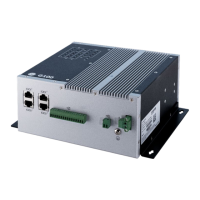G100 Instruction Manual
Wires The conductor size is from 16 AWG to 12 AWG and Strip Length is 7mm.
After plugging cable lines into the mating connector, plug the mating connector
to the product and secure the plug with the two screws.
A 20A IEC/USA/Canada breaker circuit is required as pre fuse.
A readily accessible disconnect device shall be incorporated external to the unit.
The inrush current is typically 8A when powering up.
Reverse polarity
protection
The product is equipped with built-in reverse polarity protection. If + and - are
swapped the unit will not power-up and harm to neither the power supply nor the
Overcurrent
protection
The overcurrent protection function interrupts an uncontrolled fault current or
overcurrent before serious damage can occur, such as overheating of the
equipment.
The internal fuse is rated for 10A continuous current. If that current is exceeded
by factor 10 the fuse will blow in between 1ms and 10ms.
The fuse is placed in ”+“connection of the power supply.
Power-On Self-Test (POST)
Each time the G100 boots up it must pass the POST (Power-On Self-Test).
If the G100 does not pass POST, the board will fail the POST and “beep” in a specific pattern. Please contact GE’s
Grid Solution support in this case.
Full completion of the POST and applications available to run may take up to 3 minutes.
UEFI and POST messages are displayed on the Video output (DP) port, and if enabled on
the maintenance serial port. Refer to section “Default Serial Maintenance port (port 4, RS232)” on page 52
for additional information on the serial maintenance port.
Super Capacitor and Real Time Clock (RTC)
The G100 does not include a battery. Instead, the G100 contains one super capacitor, powering the real-time
clock (RTC). This super capacitor will power the RTC for at least 5 days with no connection to power.
After this super capacitor discharges, UEFI settings will default to their factory default values (see section UEFI
Settings) and the RTC time will be reset internally to an invalid time (e.g. 12:00 AM, 01-10-2000), and will be
later updated to the correct time after the system will be powered on again and time synchronized again.
When the system is subsequently powered up, the system time will be initialized to the RTC time if the super
capacitor was not discharged. If the super capacitor was discharged, the system time will be initialized to the
last time when the system was still powered on.

